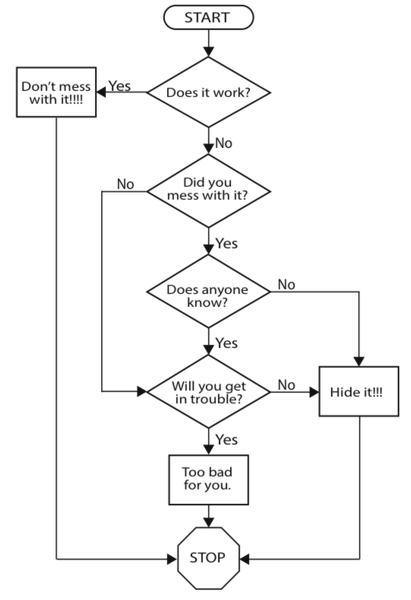Trapped in the Blame Vision

Blame Vision from Book 1: TapRooT® Root Cause Analysis Leadership Lessons, Copyright 2017. Used by permission. Duplication prohibited.
Blame Vision Example
The diagram below was given to me by a VP at a utility. He thought it was funny. In reality, it was what the workers at that utility thought of the system they lived under.

They were trapped in the Blame Vision.
The Blame Vision seems to be embedded in human nature. Perhaps it started with the legal system’s adversarial insistence on finding the guilty party. However, when this vision is used on innocent participants trying to get a job done, it often just blames those who actually are working and are unlucky.
Consequences of the Blame Vision
The best thing about the Blame Vision is that identifying the person to blame is fairly easy. Just figure out who touched the item last. Unfortunately, when a site is caught up in the Blame Vision, there are many “mystery” incidents (when hidden problems are finally discovered).
When asked what happened, employees know to act like Bart Simpson. They emphatically deny any knowledge of the problem with the following standard answer:

But management with the Blame Vision won’t let this get in their way. If you can’t find the guilty party, an acceptable solution is to arbitrarily punish a random victim. Or you can punish everyone! That way, you are sure to get the guilty party. We had a saying for this in the US Navy:
“Why be fair when you can be arbitrary?“
Ah … The stories I could tell.
Refinery Manager’s Example
A refinery manager told a story that illustrated the effect of the Blame Vision. Early in his career, he had been an engineer on a team that designed and started a new process that eventually made the company a lot of money. It had been a hard-working, close-knit team. Someone decided to organize a twenty-year reunion of all the designers, engineers, supervisors, operators, and mechanics who had worked on the project. At the reunion, everyone told stories of their part in the start-up.
One electrician told an especially interesting story. It seems that electricity to a vital part of the process was briefly lost during the plant start-up. This caused a process upset that damaged equipment and cost big bucks. Valuable time was spent trying to track down the cause of the mysterious power failure. Every possible theory was tracked down. Nothing seemed to explain it. The only explanation was that the breaker had opened and then closed itself.
The retired electrician told the rest of the story to all those present at the reunion. It seems that he had been working on a problem with another part of the process on that day. To troubleshoot the problem, he opened a breaker and de-energized what he thought was the correct system. He went to the breaker box that he thought was the appropriate breaker (the breakers weren’t labeled, but he thought he knew which one to open because he had wired most of the panel). That’s when everything went wrong. He could hear alarms from the control room. He thought something he had done caused the problem, so he quickly shut the breaker and left the area to cover up his involvement.
Later, when asked if he knew what could cause that breaker to open and shut on its own, he thought about telling the supervisor what had happened. But he knew that if he did, he’d probably be fired. So, he said he didn’t know what would cause a breaker to open and shut on its own (technically not a lie). But, since the incident was long past and he was retired, he thought the statute of limitations had run out. He admitted his mistake because it was too late to punish him.
The refinery manager then explained to his management team that he wanted to avoid needless blame and find and fix the real root causes.
Are You Trapped in the Blame Vision?

Are you trapped at a company or a site with the Blame Vision? Don’t give up hope. There are ways to change management’s vision and adopt the Opportunity to Improve Vision. Read more about the Blame Vision and the Opportunity to Improve Vision and how to transition from one to the other in Book 1: TapRooT® Root Cause Analysis Leadership Lessons.



